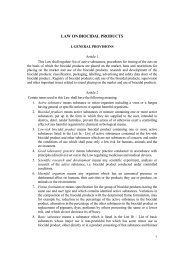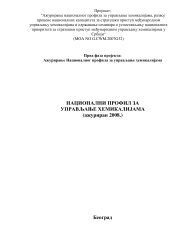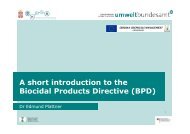GHS (CLP/GHS system) IN PRACTICE - Agencija za hemikalije
GHS (CLP/GHS system) IN PRACTICE - Agencija za hemikalije
GHS (CLP/GHS system) IN PRACTICE - Agencija za hemikalije
You also want an ePaper? Increase the reach of your titles
YUMPU automatically turns print PDFs into web optimized ePapers that Google loves.
NOTE: It is important to make sure that you choose the most appropriate method foryour mixture for each ha<strong>za</strong>rd class or category!Depending on the information available and on the ha<strong>za</strong>rd under consideration you should classify using theapproaches below in the following sequence:1. Using data on the mixture itself1. The mixture as a whole is tested2. The classification criteria are applied as for a substance3. Not applicable for CMR and some environmental ha<strong>za</strong>rd classes, but mandatory for physical ha<strong>za</strong>rds2. Classification based on the application of bridging principlesBridging principles are used for classifying untested mixtures. When a mixture has not been tested, but there aresufficient data on the components and/or similar tested mixtures, these data can be used in accordance with thefollowing bridging principles:• Diluting: if a mixture is diluted with a diluent that has an equivalent or lower toxicity, then theha<strong>za</strong>rds of the new mixture are assumed to be equivalent to the original• Batching: if a batch of a complex substance is produced under a controlled process, thenthe ha<strong>za</strong>rds of the new batch are assumed to be equivalent to the previous batches• Concentration of highly toxic mixtures: if a mixture is severely ha<strong>za</strong>rdous, then aconcentrated mixture is also assumed to be severely ha<strong>za</strong>rdous• Interpolation within one toxicity category: mixtures having component concentrations withina range where the ha<strong>za</strong>rds are known are assumed to have those known ha<strong>za</strong>rds• Substantially Similar Mixtures: slight changes in the concentrations of components are notexpected to change the ha<strong>za</strong>rds of a mixture and substitutions involving toxicologicallysimilar components are not expected to change the ha<strong>za</strong>rds of a mixture• Aerosols: an aerosol form of a mixture is assumed to have the same ha<strong>za</strong>rds as the tested,non-aerosolized form of the mixture unless the propellant affects the ha<strong>za</strong>rds upon spraying.All bridging principles do not apply to every health and environmental endpoint. Consult each endpoint todetermine which bridging principles apply!3. Classification based on the concentration of individual ingredients (using the Tables on genericconcentration limits from <strong>CLP</strong>/GSH Rulebook)3.1 Additive concentration limits• Skin corrosion/irritation• Serious eye damage/eye irritation• STOT SE, Cat. 3• Ha<strong>za</strong>rdous to the aquatic environment3.2 Non- additive concentration limits• Sensitisers (respiratory and skin)• CMR• STOT SE and RE, Cat 1-2• Aspiration ha<strong>za</strong>rd• Ha<strong>za</strong>rdous to the ozone layer4. Calculation using formulas (acute toxicity)Classification based on concentrations and the acute toxicity (ATE-values) of the ingredients by using the additivityformula.21
















